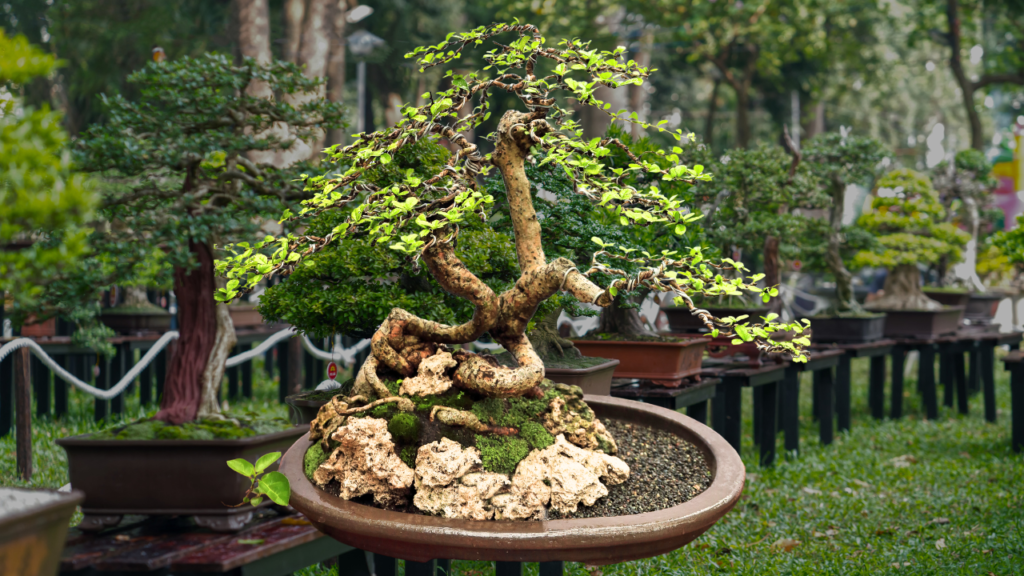Originating from China, specifically from the province of Fuijan (hence the name), the Fukien Tea is not only popular for bonsai but also holds significance in Penjing, the Chinese art of creating miniature landscapes. Its small dark-green shiny leaves, covered with fine hairs, and its ability to produce tiny white flowers that later develop into small dark berries make it a favorite among bonsai enthusiasts.
| Fukien Tea Bonsai Quick Reference | |
|---|---|
| Attribute | Information |
| 🍀Common Names | Fukien Tea, Philippine Tea, Ehretia |
| 🌿Botanical Name | Carmona retusa |
| 🍃Family | Boraginaceae |
| 🌾Plant Type | Evergreen shrub (often used as bonsai) |
| 📏Mature Size | Up to 10 ft. tall in natural habitat; typically much smaller when cultivated as bonsai |
| ☀️Sun Exposure | Full sun to partial shade |
| ✂️Pruning | Prune regularly to maintain shape; best time is late spring to early summer |
| 🎭Common Bonsai Styles | Informal upright, cascade, semi-cascade, windswept, literati |
| 🌼Bloom Time | Spring to summer |
| 🎨Flower Color | White to pale pink |
| ❄️Hardiness Zones | 10-12 (USDA) |
| 🌎Native Area | Southeast Asia, including the Philippines and Malaysia |
1. Positioning and Light:
- Sunlight: Fukien Tea thrives in bright, indirect sunlight. While it can tolerate some direct sunlight, prolonged exposure can scorch its leaves.
- Indoor vs. Outdoor: This tree is primarily an indoor bonsai, especially in non-tropical climates. However, in warm climates, it can be placed outside. It prefers a bright spot without too much direct sunlight. The optimal temperature for the Fukien Tea is around 68°F (20°C).
2. Watering:
- Frequency: The soil should be kept slightly moist at all times, as the Fukien Tea doesn’t appreciate droughts.
- Method: Use a gentle watering technique, ensuring the entire root ball is moistened. Allow excess water to drain from the pot.
3. Humidity:
- Being a tropical species, Fukien Tea appreciates higher humidity. Consider placing a humidity tray beneath the pot or misting the foliage regularly, especially if kept indoors.
4. Soil and Fertilizing:
- Soil: A well-draining soil mix, such as a blend of akadama and organic compost, is ideal.
- Fertilizing: Feed your Fukien Tea bonsai once to twice every month from spring till autumn, and reduce the frequency during the winter.
5. Pruning and Shaping:
- Pruning: The Fukien Tea can handle pruning quite well. Regular pruning will help the tree develop a dense branch structure.
- Wiring: Fukien Tea branches can be brittle, so care should be taken when wiring. It’s best to wire when the branches are younger and more flexible.
6. Repotting:
- Repot the Fukien Tea in early spring, preferably every two years. Use a standard soil mixture when repotting.
7. Pests and Diseases:
- Fukien Tea can be susceptible to pests like spider mites, aphids, and whiteflies. Regularly inspect your tree and address any issues promptly using insecticidal soap or neem oil.
8. Propagation:
- The Fukien Tea can be propagated from seeds or by using cuttings in the summer.
Bonsai Care Essentials
Conclusion:
The Fukien Tea bonsai, with its rich history and captivating appearance, is a testament to the beauty of nature in miniature. With attentive care and an understanding of its unique needs, your Fukien Tea bonsai will flourish, becoming a centerpiece of tranquility and beauty in your space.
